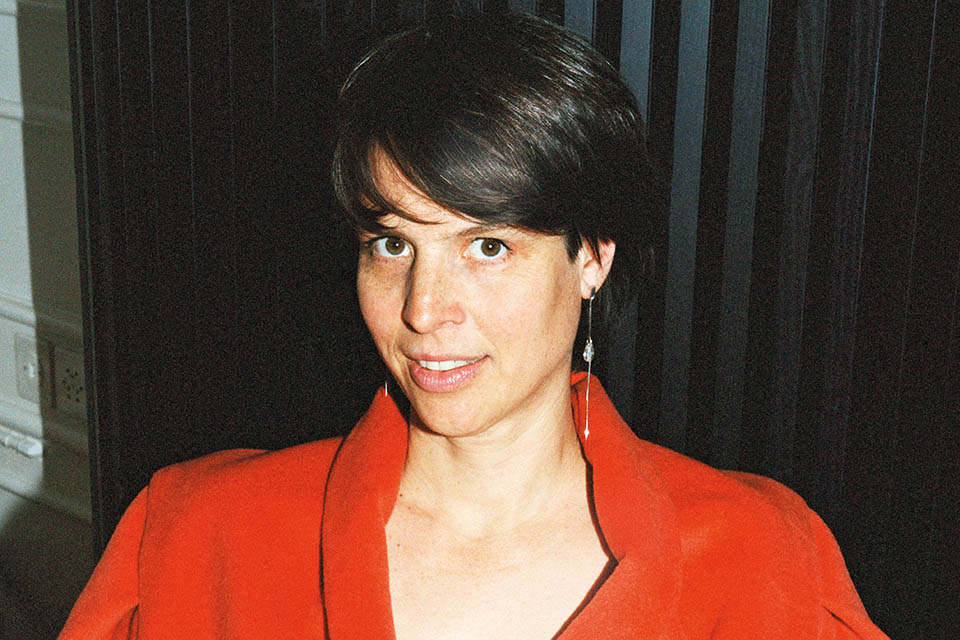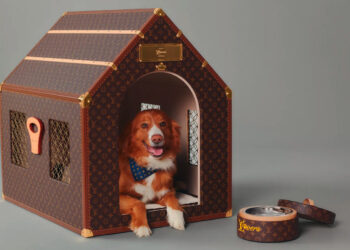She has her own label, for which she has been designing season-independent fashion for ten years, works for Balenciaga, Jakob Schlaepfer and Atelier Pfister, formerly with Walter van Beirendonck, Dries van Noten and other greats that Lela Scherrer only mentions in her CV out of necessity. While other people’s jaws drop when they study the same thing, the Basel native shrugs her shoulders, seeing the design profession for what it is: hard work.
FACES: Your own collection is only one part of your work. What do you answer when someone asks you what you do and what work is currently on your desk?
Lela Scherrer: As a designer, I work specifically on mainly textile fashion and interior products, develop design concepts for clients and work in the field of design research as well as in an advisory capacity, including in the retail sector. So there are always various projects and works not only on the table, but also on the floor and hanging on busts and over clothes rails. Currently, these include research ideas for collections and objects, textile developments in the field of interior design, ideas for collaboration with artists, research and developments for our own work – and admin…
F: What do you enjoy most about your job, and what part don’t you like at all?
LS: I love immersing myself in worlds, researching materials and colors, the spatial development of clothes through to the finalization in the form of photos or other forms of presentation, as well as the collaboration and exchange with other professionals – teams, partners, customers or producers, but also students. It’s great to work internationally, I love traveling, languages and people and I’m excited about my network, it’s part of my capital. The administrative work as a self-employed person doesn’t excite me. I find the attitudes that are repeatedly encountered in our profession and the lack of partnership between the parties involved exhausting.
F: Textile design is an important part of fashion, albeit an underestimated one. How do you approach a project when you design fabrics?
LS: That depends on the project. Numerous ideas for my own work are already lying and hanging here in the studio, waiting to be realized. These often reappear in orders. For the latter, my visions for the customer and the exchange with them provide the input. Then the research begins and I submit ideas and later drafts. The discussion with the counterpart is decisive for the design before the realization begins in cooperation with textile companies.
F: You advise numerous companies and also research design yourself. What exactly does this mean?
LS: That also depends on the other person or of the question. I draw on knowledge and a network that I have built up over the years and develop solutions with the partners. In design research, I am usually involved in the implementation phase. This field is very broad and includes everything that affects our industry and the extended field. We learn a lot when we think outside the box and find out how other industries do things.
F: You work for Balenciaga, among others. How did you get this job, and how do you manage to get one in the first place?
LS: I have previously worked with Balenciaga’s Artistic Director for various brands in the Benelux. As we enjoy working together, this collaboration also came about.
“Designer is a job like any other. The key question is whether you can develop within it.”
F: Why did you choose to work in the fashion and design industry?
LS: Because this profession is so multifaceted and encompasses practically everything that interests me.
F: Is designer a dream job?
LS: Designer is a job like any other. The key question is whether you can develop within it.
F: How important are major design schools like Central Saint Martins College or Parsons School of Design?
LS : The entry into professional life can be a little less bumpy because the network of these schools works well. However, the market is oversaturated and entry into professional life has become even more difficult.
F: Disillusioned young designers and collections that nobody buys: How do you assess the situation of designers at the present time?
LS : The chance of remaining successful on the market as a designer – not just being successful – depends on a unique business concept. Many designers are still trying to establish themselves in the old fashion system, which has definitely been a thing of the past since Corona. Ignoring the large entrepreneurial part of working as a freelance designer is fatal.
F: How important is federal and foundation funding for Swiss designers, and would you like to see more national support?
LS: Professional and ongoing start-up support makes sense. However, there is a lack of understanding of the whole arc of a designer’s career in Switzerland, in the press and also among sponsors. Design is still marginally recognized in Switzerland. For design to be perceived clearly and with clear relevance in Switzerland, there needs to be a continuous presence of designers in all phases of their career, not just as young designers and in the final phase of their career. Appropriate support would be desirable.
F: What kind of people are designers?
LS: Fortunately, there is no universally valid definition for any profession. I like designers who push boundaries, question everything and realize the impossible.
F: You worked with Walter van Beirendonck and Dries van Noten. How great is the reverence for such names?
LS: It is superfluous in the studio when you work together. It’s great what you can learn from experienced designers. It’s nice to realize that we are all “only” human.
F: Do designers tend to be introverts or extroverts?
LS: I hardly know any introverted designers. Most of them are outgoing and curious.
F: What’s your take on the fashion industry?
LS: In my opinion, professional ethics and respect are not found enough.
F: Do we need fashion weeks like Fashion Week in Paris or Milan?
LS : A professional meeting is essential – in what form remains to be seen.
F: Is fashion today more commerce than art?
LS: Designers and artists also have to be able to pay their rent and buy food. So we all need to be able to sell our work. It would be helpful to put these romantic, naive professional ideals to one side – it’s a business like any other.
F: What’s the hardest lesson you’ve learned in the fashion industry, and what’s the most important?
LS : Experiencing the fundamental prevalence of egotism is hard as a young designer. Fortunately, you also meet other people. These are then all the more valuable, professional and friendly. For me, authenticity on a personal, professional and creative level is particularly important.
F: What’s the best advice you’ve ever received?
LS: I got it from a colleague at Walter van Beirendonck. He was head of sales at Dries van Noten in the early years: Generous receiving requires generous giving. It’s a generous give and take….
F: What has the current pandemic helped you with, and how is it getting in your way?
LS: It helped us to focus on everything relevant – both professionally and privately – and helped us to slow down and relax. It stands in my way insofar as it is much more difficult to stay in contact with professionals and discover new things without traveling and without trade fairs in the art and design sector.
F: Why is it so important to keep breaking out of your comfort zone or not create one in the first place?
LS: I believe that innovation and creativity cannot exist in the comfort zone. It makes me happy, even if it is a rather strenuous life – but never monotonous and with many challenges.
F: You lived in Belgium for a long time before moving back to Switzerland. What did you miss abroad, and what do you miss here?
LS: I didn’t really miss much in Belgium, mainly my family, maybe the organization of Switzerland. Belgium is quite chaotic in many respects. Of course, this also has its good sides – Belgium is also known as the land of back doors. This makes many things possible that are made impossible here by regulations and expensive living. I miss this unrestricted approach here.
F: What does Basel have that other cities don’t?
LS : The importance of art and architecture in such a small city is great, especially during the trade fair. The border with two large European countries is also extraordinary and noticeable. The presence of international corporations with their employees from all over the world is more noticeable than it was 15 years ago, and that is very good for this city.
F: Which is the most important contact of your international network, and when do you use it?
LS : I really value my international network and have no specific preferences. Maintaining the network and working with heart are important to me. Professional contacts on a friendly and respectful level are essential for me.
F: Antwerp, the metropolis of fashion. Why is it worth visiting this particular city as a designer, and why did you move there?
LS : The presence, the understanding and also the naturalness of design cannot be compared with what we know here. You can also feel this when you visit this city, even though Antwerp, like other cities, has also been hit by the crisis and the abundance has decreased. During my studies I was enthusiastic about Walter van Beirendonck and his W< collections and shows. That’s why I wanted to work for him at the time, and it worked out.
F: Your own collections are season-independent. How long will it take for the big players in the industry to move away from trend collections, and what will it take?
LS : Since corona and the strong focus on sustainability, this has been obvious. Many brands are already in the process of converting. Ultimately, however, it’s not just about switching, but about consuming less, which is linked to informing and educating consumers. For me personally, it’s been the only way to make clothes for ten years. Enthusiasm grows with the idea of producing individual pieces or, at most, small series. It gives me a great deal of creative freedom.
F: What’s the best way to switch off?
LS: When I have family time, meet friends or do something good for myself: massage, yoga, tennis… the classics. Or when I’m traveling.
F: What do you collect?
LS: I only allow myself to collect in the studio – extraordinary materials of all kinds…















